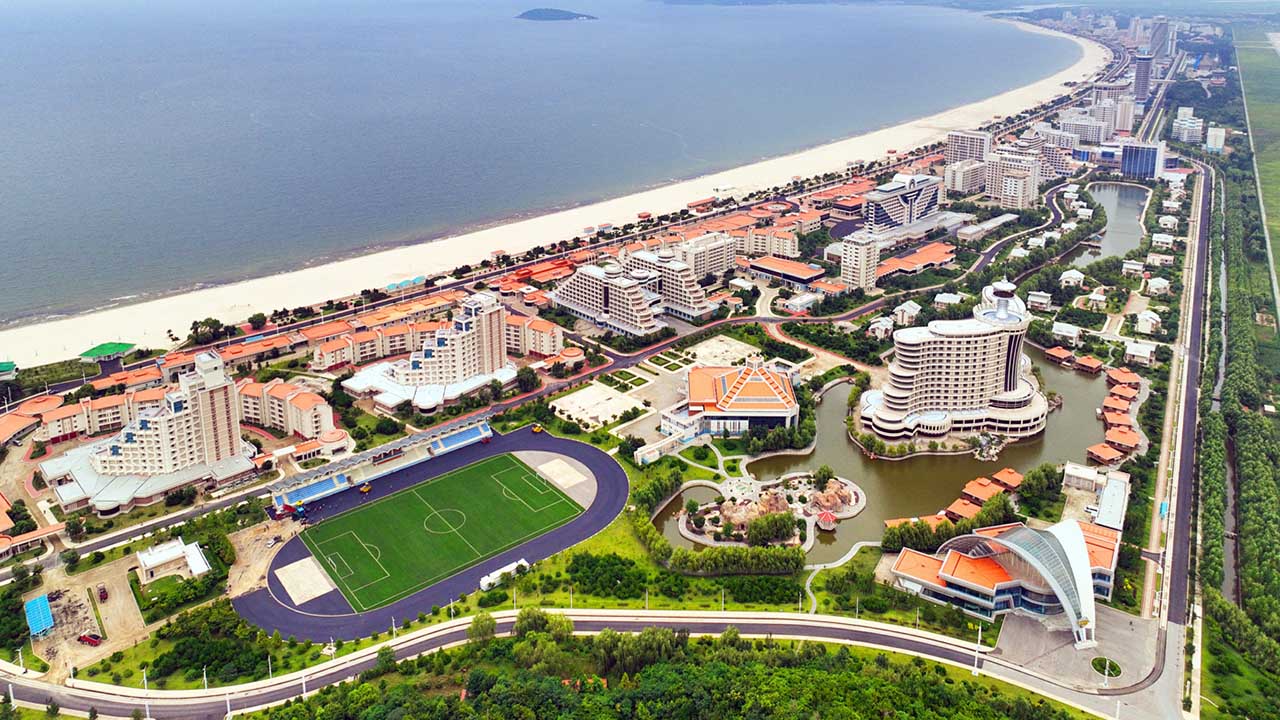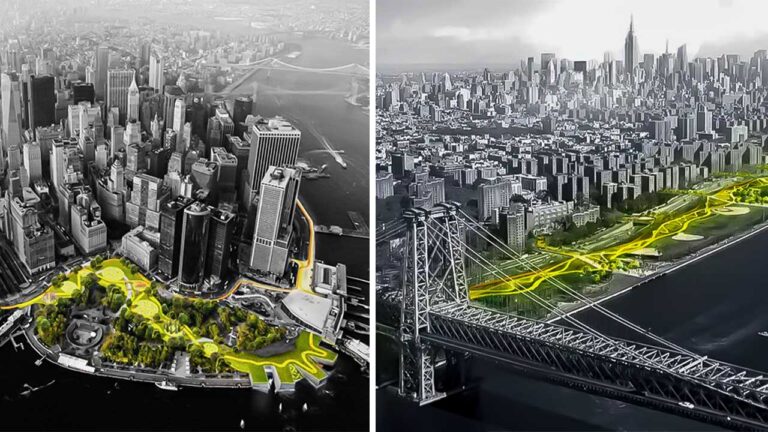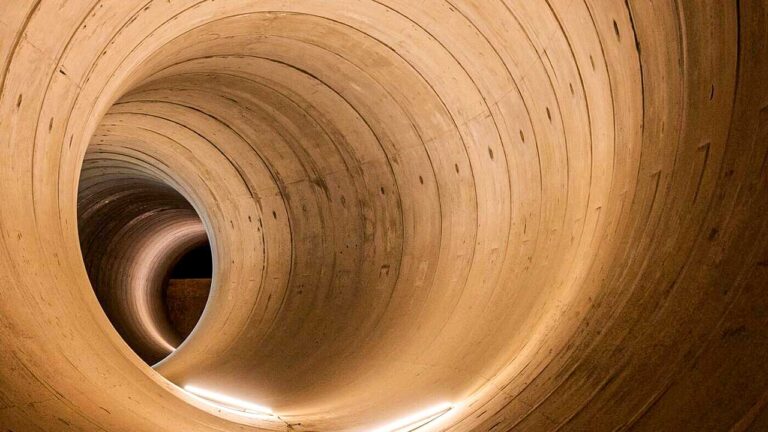Wonsan Kalma Coastal Tourist Zone: North Korea’s Most Ambitious Resort Project
North Korea rarely appears in conversations about tropical escapes or luxury coastal destinations, yet the country’s eastern shoreline tells a very different story. Tall hotels rise over clear blue water, long boulevards frame the coastline, and wide beaches stretch farther than the eye can see. Water slides gleam under the sun, and volleyball courts sit on carefully groomed sand. This is the Wonsan Kalma Coastal Tourist Zone, a state-built beachfront complex designed to hold nearly twenty thousand visitors. Propaganda posters call it “the world’s most beautiful beach.” Standing there myself once, I felt how surreal it was to see a place like this in one of the world’s most isolated states.
A Coastline Chosen With Purpose
The resort sits along a four-kilometer strip of sand near the port city of Wonsan. Its location was never a simple choice. Wonsan holds deep strategic and symbolic weight inside North Korea. It contains a major naval base, a renovated international airport, and a designated economic zone meant to attract controlled forms of foreign investment. These elements give the area rare importance. The state sees Wonsan as a place where military influence, economic ambition, and limited international exposure can comfortably coexist.
A personal element also shapes the story. Kim Jong-un’s family has long maintained a residence in the region, and many analysts believe he spent part of his childhood summers on this same coastline. Turning Wonsan into a polished resort gave him a chance to reshape a familiar place into a national showpiece.
The idea began taking shape in 2013 when officials announced plans to turn the region into a model coastal city. They envisioned upgraded airports, new roads, luxury hotels, leisure districts, and modern marinas. The goal was to build a space that could convince outsiders that North Korea was ready to join global tourism, yet still remain firmly in state control.
Also Read: Stargate: Inside the Half-Trillion-Dollar AI Infrastructure Megaproject Reshaping Global Power
A Decade of Construction Through Turbulent Times
The Wonsan Kalma project became public in 2014, backed by glossy renderings and confident statements from state media. The blueprint included dozens of hotels, beachfront villas, amusement parks, a dolphinarium, and long recreational promenades. On paper, it resembled the kind of large-scale resort developments seen in China’s Hainan or Vietnam’s Da Nang.
The timeline quickly began to slip. Sanctions tightened after repeated missile tests. Imported materials grew harder to secure. Construction crews worked in irregular patterns since many resources had to be diverted to housing projects in Pyongyang. When the pandemic struck in 2020, North Korea sealed its borders and cut almost all external contact, which pushed the resort even further into delay.
Satellite data collected by independent analysts at organizations like 38 North and CSIS confirmed these irregular cycles. Progress came in brief bursts followed by long pauses. Workers completed major hotel structures, then abandoned them for months. Landscaping appeared finished in some areas, then deteriorated. Despite this uneven pace, the country continued to push forward because the project carried symbolic weight.
This slow, heavy path mirrors many of North Korea’s high-profile developments. Pyongyang’s skyline is full of buildings constructed to signal power rather than practicality. The Ryugyong Hotel, once intended to become the world’s tallest hotel, stood unfinished for decades. Ryomyong Street, Masikryong Ski Resort, and Yangdok Hot Springs Spa all represent the same drive: grand, visually striking projects built to make a political point, even if they struggle to operate at full capacity.
Wonsan Kalma fits this pattern. It stands as proof that the country can create structures comparable to global resorts, even under sanctions and economic strain.
A Resort Built to Tell a Political Story
At first glance, Wonsan Kalma looks like a simple tourist complex. Yet its real purpose reaches much deeper. Every feature serves the narrative the regime wants to present: North Korea is orderly, capable, and confident.
Kim Jong-un’s personal inspection tours strengthened that message. His appearance on construction sites placed him at the heart of the story, reinforcing the image of a leader guiding national progress. The architecture carries visual cues that resemble modern resorts in China, Russia, Southeast Asia, and even the Middle East. These similarities seem intentional. They send a quiet message that North Korea belongs on the same stage as fast-growing tourist economies, at least in appearance.
The resort became a tool for political storytelling. State media described it as a symbol of strength, persistence, and self-reliance. Workers were praised as heroes. The project allowed the leadership to shape a narrative of forward motion, even during years of economic hardship.
Tourism and the Push for Foreign Revenue
Tourism has long offered North Korea a rare window to earn foreign currency without directly clashing with international restrictions. Travelers from Russia, China, and a handful of other countries pay in dollars, euros, or yuan. Those funds are vital for the regime’s internal budget.
The Wonsan Kalma resort was designed with that goal in mind. Early plans aimed to bring Russian tour groups through charter flights, followed by larger numbers from China and Southeast Asia. North Korean officials even promoted the area at travel conferences in Moscow and Beijing before the pandemic.
Inside the country, propaganda films depict the resort as a place where ordinary citizens enjoy summer breaks. Families walk along boardwalks. Children play on water slides. Couples relax on the sand. In reality, most North Koreans cannot afford to stay in such facilities, and priority often goes to political elites or military groups.
Infrastructure challenges make large-scale tourism even more difficult. Wonsan’s airport received significant upgrades, but it still handles almost no foreign flights. Fuel shortages limit domestic travel. Road connections remain narrow, slow, and vulnerable to weather. Electricity supplies across the region are inconsistent, which complicates hotel operations.
Since 2020, border closures have frozen almost all tourism. Even after North Korea reopened parts of its border in 2023, large visitor flows have not resumed.
A Stage for Diplomacy and Soft Influence
The political value of Wonsan Kalma extends beyond tourism revenue. Hosting outsiders allows North Korea to shape its international image. Instead of missile tests dominating headlines, the state can highlight beaches, hotels, and carefully curated leisure scenes.
Russia has been the main focus of these outreach efforts. Political ties between Pyongyang and Moscow have grown closer since 2022, fueled by international isolation and military cooperation. Bringing Russian tourists to Wonsan fits within that larger relationship. It offers both countries a low-risk way to deepen engagement under the radar of global tensions.
Every visitor entering the resort becomes part of that diplomatic message. The state shows that it can welcome foreigners on its own terms. Yet cautious neighbors and ongoing sanctions prevent any major breakthrough. Without broader reforms or transparency, the resort’s global influence remains limited.
Future Plans and the Struggle Ahead
North Korea has spoken about broader tourism ambitions, including mountain resorts, upgraded ports, and expanded recreational zones. Many of these ideas reach the announcement stage, then fade. The pattern repeats because large projects require stable financing, foreign partnerships, and open borders. None of these conditions currently exist.
For Wonsan Kalma to survive and grow, the country must reopen fully, stabilize infrastructure, and earn the trust of international travelers. Safety, reliability, and accessibility matter deeply in tourism, and these factors remain uncertain.
Also Read: Chongqing Metro: The World’s Most Extreme Transit System
Still, the resort offers a rare window into the state’s mindset. It shows a leadership eager to display modernity, eager to claim progress, and eager to create tightly controlled channels for foreign interaction. Even if the hotels stay empty or operate at reduced capacity, the project serves its symbolic purpose.
What Wonsan Kalma Really Represents?
Beneath the bright colors and long beachfront sits a story of ambition shaped by isolation. The Wonsan Kalma Coastal Tourist Zone stands as both a proud showcase and a reminder of the country’s challenges. It reveals a desire to appear open, confident, and capable, yet it also exposes the limits imposed by sanctions, politics, and economic strain.
The resort raises an important question for anyone who studies North Korea’s mega projects: does it represent genuine change or a carefully staged illusion meant to shape global perception?
As you explore the world of complex infrastructure and high-stakes national ambitions, this project offers a clear example of how construction can carry meaning far beyond its physical form.







